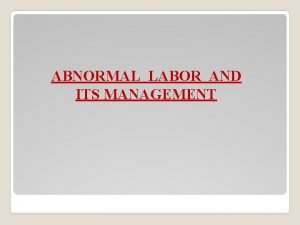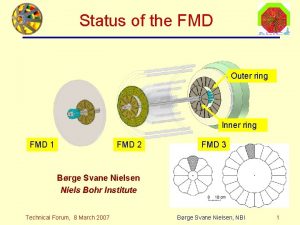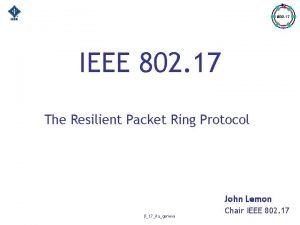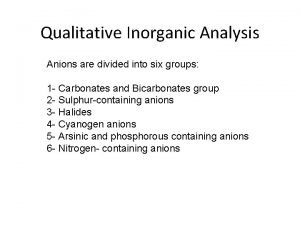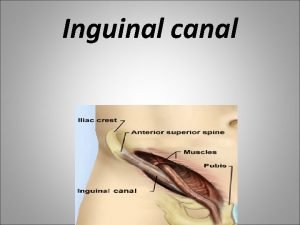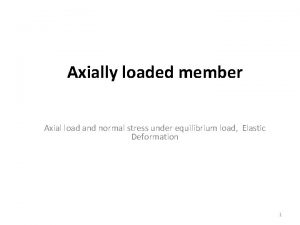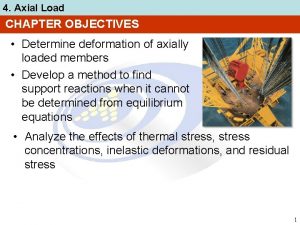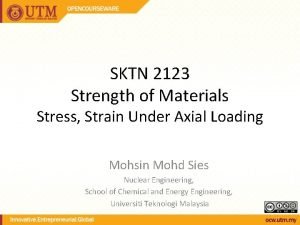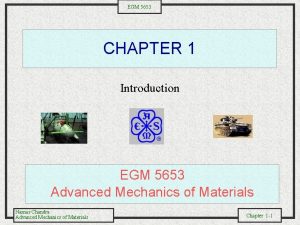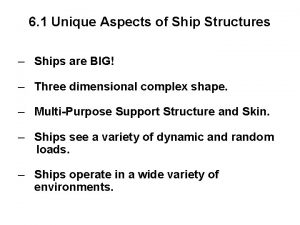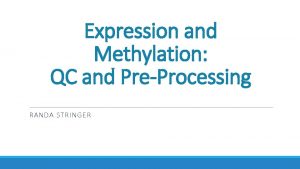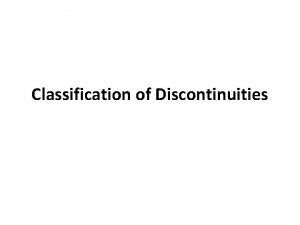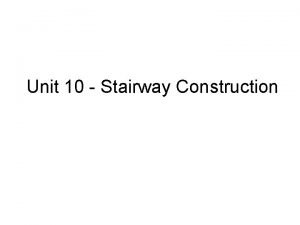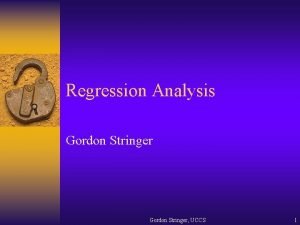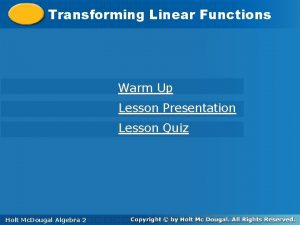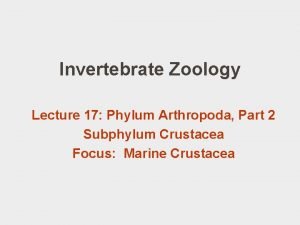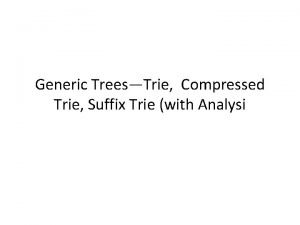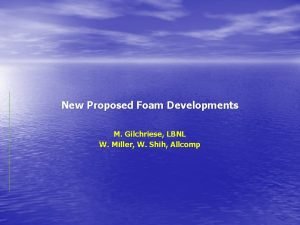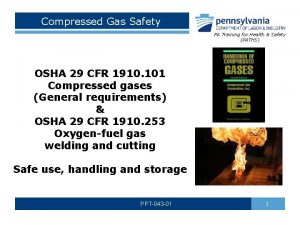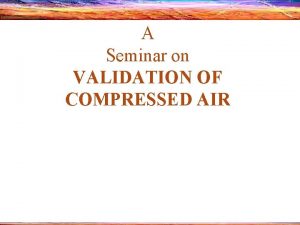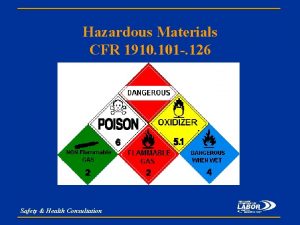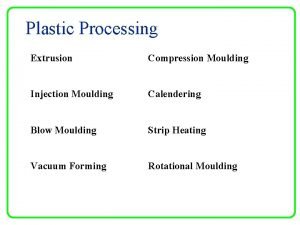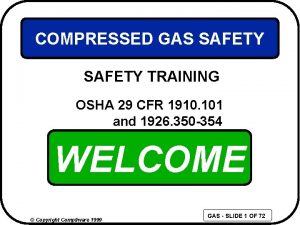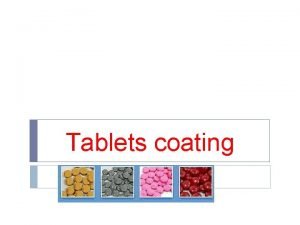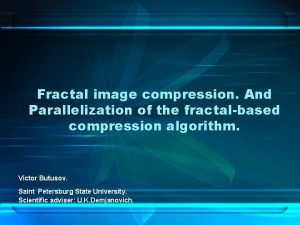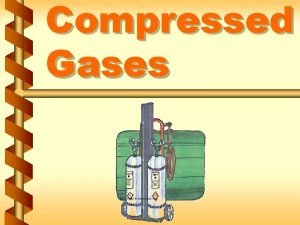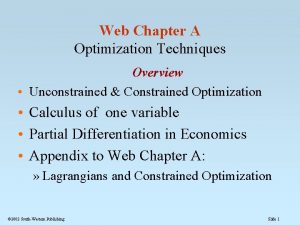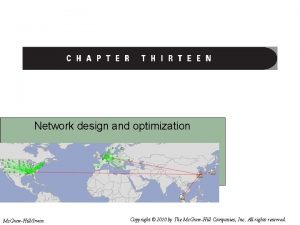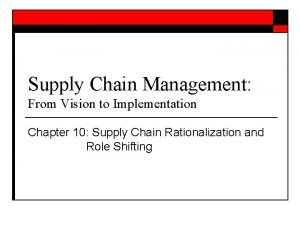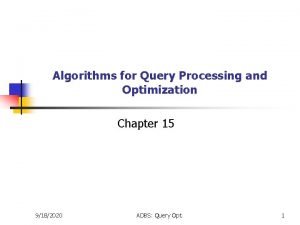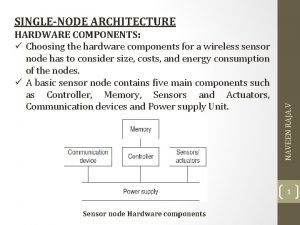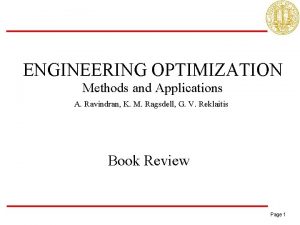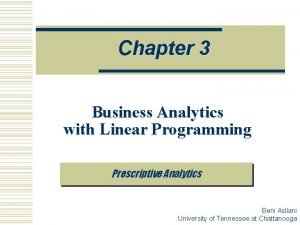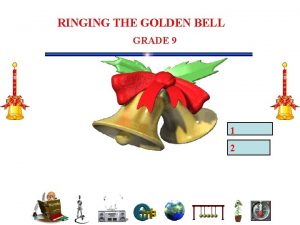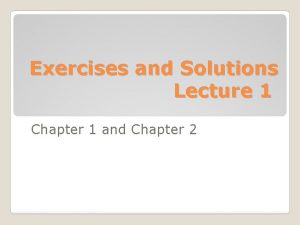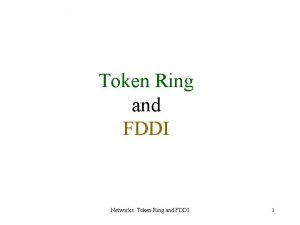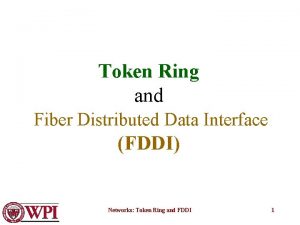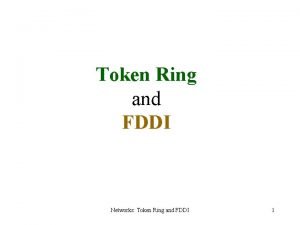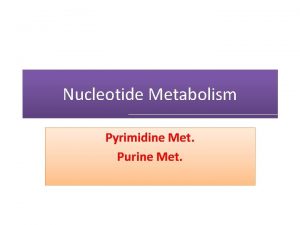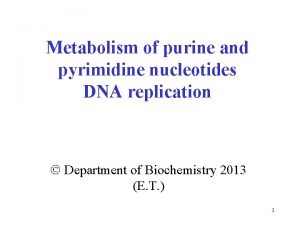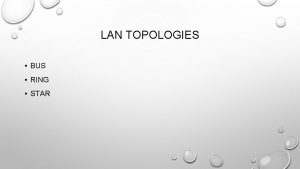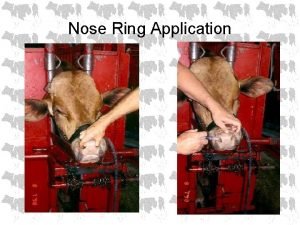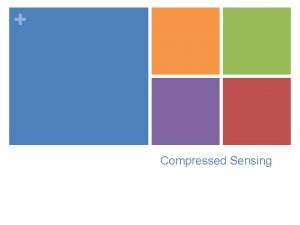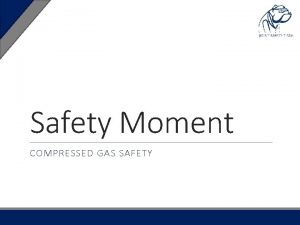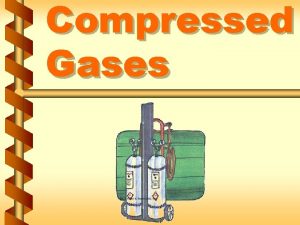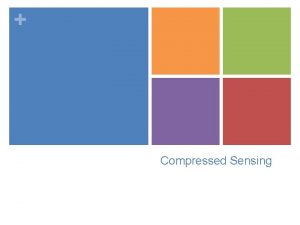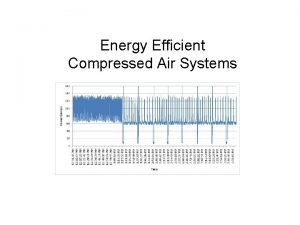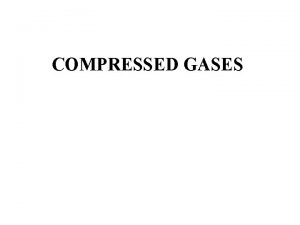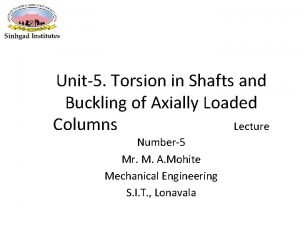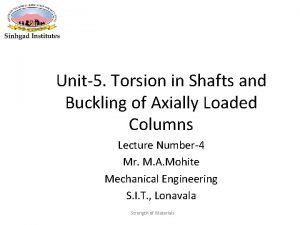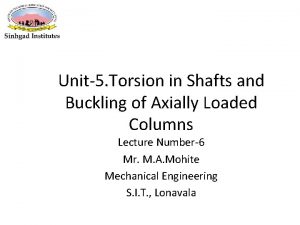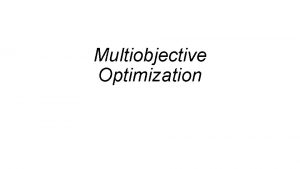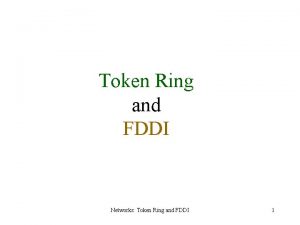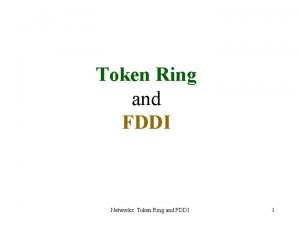OPTIMIZATION OF AN AXIALLY COMPRESSED RING AND STRINGER









































































- Slides: 73

OPTIMIZATION OF AN AXIALLY COMPRESSED RING AND STRINGER STIFFENED CYLINDRICAL SHELL WITH A GENERAL BUCKLING MODAL IMPERFECTION AIAA Paper 2007 -2216 David Bushnell, Fellow, AIAA, retired

In memory of Frank Brogan, 1925 2006, co-developer of STAGS

Summary of talk 1. The configuration studied here 2. Two effects of a general imperfection 3. PANDA 2 and STAGS 4. PANDA 2 philosophy 5. Seven cases studied here 6. The optimization problem 7. Buckling and stress constraints 8. Seven cases explained 9. How the shells fail 10. Imperfection sensitivity

General buckling mode from STAGS 50 in. External T-stringers, Internal T-rings, 75 in. Loading: uniform axial compression with axial load, Nx = -3000 lb/in This is a STAGS model.

Expanded region of buckling mode

TWO MAJOR EFFECTS OF A GENERAL IMPERFECTION 1. The imperfect shell bends when any loads are applied. This “prebuckling” bending causes redistribution of stresses between the panel skin and the various segments of the stringers and rings. 2. The “effective” radius of curvature of the imperfect and loaded shell is larger than the nominal radius: “flat” regions develop.

Loaded imperfect cylinder Maximum stress, sbar(max) =66. 87 ksi “Flat” region

The entire deformed cylinder

The area of maximum stress

The “flattened” region

Computer programs PANDA 2 and STAGS PANDA 2 optimizes ring and stringer stiffened flat or cylindrical panels and shells made of laminated composite material or simple isotropic or orthotropic material. The shells can be perfect or imperfect and can be loaded by up to five combinations of Nx, Ny Nxy. STAGS is a general-purpose program for the nonlinear elastic or elastic-plastic static and dynamic analyses. I used STAGS to check the optimum designs previously obtained by PANDA 2.

PHILOSOPHY OF PANDA 2 1. PANDA 2 obtains optimum designs through the use of many relatively simple models, each of which yields approximate buckling load factors (eigenvalues) and stresses. 2. 2. Details about these models are given in previous papers. Therefore, they are not repeated here. 3. 3. “Global” optimum designs can be obtained reasonably quickly and are not overly unconservative or conservative. 4. Because of the approximate nature of PANDA 2 models, optimum designs obtained by PANDA 2 should be checked by the use of a general-purpose finite element computer program. 5. STAGS is a good choice because PANDA 2 automatically generates input data for STAGS, and STAGS has excellent reliable nonlinear capabilities.

Example of PANDA 2 philosophy PANDA 2 computes general buckling from a simple closed-form model in which the stringers and rings are “smeared out” as prescribed by Baruch and Singer (1963). [Bushnell (1987)] Correction factors (knockdown factors) are computed to compensate for the inherent unconservativeness of this “smeared” model: one knockdown factor for “smearing” the stringers and another knockdown factor for “smearing” the rings. The next several slides demonstrate why a knockdown factor is needed to compensate for the inherent unconservativeness of “smearing” the rings and how this knockdown factor is computed.

A general buckling mode from STAGS Next slide shows detail in this region

Detail showing local/global deformation in STAGS model Note the local deformation of the outstanding ring flange in the general buckling mode

The same general buckling mode from BIGBOSOR 4 (Bushnell, 1999). n = 3 circumferential waves Deformed Undeformed Buckling model shown on next slide

Approximate BIGBOSOR 4 model of general buckling, n = 3 Note the deformation of the outstanding flange of the ring. Symmetry Undeformed Symmetry Deformed

Knockdown factor to compensate for inherent unconservativeness of “smearing” rings Ring knockdown factor = (Buckling load from the BIGBOSOR 4 model)/ (“Classical” ring buckling formula) “Classical” ring buckling formula= (n 2 - 1) EI/r 3

SEVEN PANDA 2 CASES IN TABLE 4 OF THE PAPER Case 1: perfect shell, “no Koiter”, ICONSV=1 Case 2: imperfect, “no Koiter”, yes change imperf. , ICONSV=-1 Case 3: imperfect, “no Koiter”, yes change imperf. , ICONSV= 0 Case 4: imperfect, “no Koiter”, yes change imperf. , ICONSV =1 Case 5: imperfect, “yes Koiter”, yes change imperf. , ICONSV=1 Case 6: as if perfect, “no Koiter”, Nx=-6000 lb/in, ICONSV= 1 Case 7: imperfect, “no Koiter”, no change imperf. , ICONSV= 1

Summary of talk 1. The configuration studied here 2. Two effects of a general imperfection 3. PANDA 2 and STAGS 4. PANDA 2 philosophy 5. Seven cases studied here 6. The optimization problem 7. Buckling and stress constraints 8. Seven cases explained 9. How the shells fail 10. Imperfection sensitivity

Decision variables for PANDA 2 optimization Stringer spacing B(STR), Ring spacing B(RNG), Shell skin thickness T 1(SKIN) T-stringer web height H(STR) and outstanding flange width W(STR) T-stringer web thickness T 2(STR) and outstanding flange thickness T 3(STR) T-ring web height H(RNG) and outstanding flange width W(RNG) T-ring web thickness T 4(RNG) and outstanding flange thickness T 5(RNG)

OBJECTIVE = MINIMUM WEIGHT

Global optimization: PANDA 2 Objective, weight Each “spike” is a new “starting” design, obtained randomly. Design iterations

CONSTRAINT CONDITIONS Five classes of constraint conditions: 1. Upper and lower bounds of decision variables 2. Linking conditions 3. Inequality constraints 4. Stress constraints 5. Buckling constraints

DEFINITIONS OF MARGINS Buckling margin= (buckling constraint) -1 (buckling constraint) = (buckling load factor)/(factor of safety) Stress margin = (stress constraint) - 1. 0 (stress constraint) = (allowable stress)/ [(actual stress)x(factor of safety)]

TYPICAL BUCKLING MARGINS 1. Local buckling from discrete model 2. Long-axial-wave bending-torsion buckling 3. Inter-ring buckling from discrete model 4. Buckling margin, stringer segment 3 5. Buckling margin, stringer segment 4 6. Buckling margin, stringer segments 3 & 4 together 7. Same as 4, 5, and 6 for ring segments 8. General buckling from PANDA-type model 9. General buckling from double trig. series expansion 10. Rolling only of stringers; of rings

Example of local buckling: STAGS Case 2 P(crit)=1. 0758 (STAGS) P(crit)=1. 0636 (PANDA 2) P(crit)=1. 0862 (BOSOR 4)

Example of local buckling: BIGBOSOR 4 Case 1

Example of bending-torsion buckling P(crit)=1. 3826 (STAGS) P(crit)=1. 378 or 1. 291 (PANDA 2) P(crit)=1. 289 (BOSOR 4) STAGS model, Case 2

Bending-torsion buckling: BIGBOSOR 4 Case 2

Example of general buckling: STAGS Case 2 P(crit)=1. 9017 (STAGS) P(crit)=1. 890 (PANDA 2) P(crit)=1. 877 (BOSOR 4)

Example of general buckling: BIGBOSOR 4

Multiple planes of symmetry 60 -degree model: STAGS model

60 -degree STAGS model: End view

Close-up view of part of 60 -deg. model STAGS model

60 -degree STAGS model Case 2 Detail shown on the next slide

Detail of general buckling mode STAGS model, Case 2

TYPICAL STRESS MARGINS 1. Effective stress, material x, location y, computed from SUBROUTINE STRTHK (locally post-buckled skin/stringer discretized module) 2. Effective stress, material x, location y, computed from SUBROUTINE STRCON (No local buckling. Stresses in rings are computed)

Buckling and stress margins in PANDA 2 design sensitivity study Case 4 Design margins 0 Margin Optimum configuration H(STR)

Summary of talk 1. The configuration studied here 2. Two effects of a general imperfection 3. PANDA 2 and STAGS 4. PANDA 2 philosophy 5. Seven cases studied here 6. The optimization problem 7. Buckling and stress constraints 8. Seven cases explained 9. How the shells fail 10. Imperfection sensitivity

SEVEN PANDA 2 CASES Case 1: perfect shell, “no Koiter”, ICONSV=1 Case 2: imperfect, “no Koiter”, yes change imperf. , ICONSV=-1 Case 3: imperfect, “no Koiter”, yes change imperf. , ICONSV= 0 Case 4: imperfect, “no Koiter”, yes change imperf. , ICONSV =1 Case 5: imperfect, “yes Koiter”, yes change imperf. , ICONSV=1 Case 6: as if perfect, “no Koiter”, Nx=-6000 lb/in, ICONSV= 1 Case 7: imperfect, “no Koiter”, no change imperf. , ICONSV= 1

THE MEANING OF “ICONSV” ICONSV = 1 (the recommended value): 1. Include the Arbocz theory for imperfection sensitivity. 2. Use a conservative knockdown for smearing stringers. 3. Use the computed knockdown factor for smearings. ICONSV = 0: 1. Do not include the Arbocz theory. 2. Use a less conservative knockdown for smearing stringers. 3. Use the computed knockdown factor for smearings. ICONSV = -1: Same as ICONSV=0 except the knockdown factor for smearings is 1. 0 and 0. 95 is used instead of 0. 85 for ALTSOL.

THE MEANING OF “YES CHANGE IMPERFECTION” The general buckling modal imperfection amplitude is made proportional to the axial wavelength of the critical general buckling mode shape.

A simple general buckling modal imperfection Wimp = 0. 25 inch STAGS model: Case 1 P(crit) = 1. 090, Case 1

A “complex” general buckling modal imperfection Wimp =0. 25/4. 0 inch Case 1 P(crit) = 1. 075, Case 1

“Oscillation” of margins with “no change imperfection” option Design Margins 0 Margin Design Iterations

“Oscillation” of margins with “yes change imperfection” option Design Margins 0 Margin Design Iterations

THE MEANING OF “NO” AND “YES KOITER” “NO KOITER” = no local postbuckling state is computed. “YES KOITER” = the local postbuckling state is computed. A modified form of the nonlinear theory by KOITER (1946), BUSHNELL (1993) is used.

Local postbuckling: PANDA 2 A single discretized skin-stringer module model (BOSOR 4 -type model) of the Case 4 optimum design as deformed at four levels of applied axial compression, Nx.

Case 4 with “no Koiter” and with “yes Koiter” Margins Design load Stress margins computed with “no Koiter” Stresses computed with “yes Koiter” PANDA 2 results: stress margins Nx

Case 4: Initial imperfection shape General buckling mode from STAGS 60 -degree model Imperfection amplitude, Negative Wimp = -0. 25/4. 0 = -0. 0625 in.

Load-stress curve: static & dynamic Load factor, PA Design Load, PA = 1. 0 Dynamic Phase, PA=1. Static phase, PA = 0 to 0. 98 STAGS results Effective stress in panel skin

Deformed panel at PA=0. 98 Maximum Stress before dynamic STAGS run = 63. 5 ksi See the next slide for detail. STAGS results

Example 1 of stress in the imperfect panel Maximum effective (von Mises) stress in the entire panel, 63. 5 ksi. (Case 4 nonlinear STAGS static equilibrium at load factor, PA = 0. 98, before the STAGS dynamic run)

Example 1 of stress in the panel skin Maximum effective (von Mises) stress in the panel skin= 47. 2 ksi (Case 4 nonlinear STAGS static equilibrium at load factor, PA = 0. 98, before the STAGS dynamic run)

STAGS nonlinear dynamic response Load factor held constant at PA= 1. 0 Stress Previous 2 Next 2 slides, PA = slides, 0. 98 PA =1. 0 Stress in the panel skin. Time

Example 2 of stress in the imperfect panel Maximum effective (von Mises) stress in the entire panel, 70. 38 ksi (Case 4 STAGS nonlinear static equilibrium after the dynamic STAGS run at load factor, PA = 1. 00)

Example 2 of stress in the panel skin Maximum effective (von Mises) stress in the panel skin=60. 6 ksi (Case 4 nonlinear STAGS static equilibrium after dynamic STAGS run at load factor, PA = 1. 00)

Shell optimized with “yes Koiter” Maximum stress=57. 3 ksi, next slide STAGS result at PA = 1. 0, Case 5

Detail from previous slide: PA = 1. 0 Maximum stress=57. 3 ksi

OPTIMIZED WEIGHTS FOR CASES 1 - 7: PANDA 2 CASE WEIGHT(lb) 1 2 3 4 5 6 7 COMMENT 31. 81 perfect shell, no Koiter, ICONSV=1 39. 40 imperfect, no Koiter, yes change imp. , ICONSV=-1 40. 12 imperfect, no Koiter, yes change imp. , ICONSV= 0 40. 94 imperfect, no Koiter, yes change imp. , ICONSV= 1 41. 89 imperfect, yes Koiter, yes change imp. , ICONSV= 1 46. 83 as if perfect, no Koiter, Nx = -6000 lb/in, ICONSV= 1 56. 28 imperfect, no Koiter, no change imperf. , ICONSV=1

Summary of talk 1. The configuration studied here 2. Two effects of a general imperfection 3. PANDA 2 and STAGS 4. PANDA 2 philosophy 5. Seven cases studied here 6. The optimization problem 7. Buckling and stress constraints 8. Seven cases explained 9. How the shells fail 10. Imperfection sensitivity

60 -degree STAGS model of Case 2: General buckling mode Next, show a shell with this imperfection collapses. Wimp = -0. 25/4. 0 Use NEGATIVE of this mode as the imperfection shape.

Deformed shell at PA=1. 02 with negative of general buckling mode Next Slide Case 2 STAGS model

Enlarged view of collapsing zone Case 2 STAGS model at PA=1. 02

Sidesway of central stringers vs PA Static Dynamic Design Load Case 2 STAGS results Sidesway

Deformation after dynamic run Case 2 STAGS results at PA=1. 04

Summary of talk 1. The configuration studied here 2. Two effects of a general imperfection 3. PANDA 2 and STAGS 4. PANDA 2 philosophy 5. Seven cases studied here 6. The optimization problem 7. Buckling and stress constraints 8. Seven cases explained 9. How the shells fail 10. Imperfection sensitivity

Imperfection sensitivity, Case 5 Nx(crit) (lb/in) Effective thickness of stiffened shell=0. 783 in. PANDA 2 results: Case 5 Wimp “yes change imperfection amplitude” Design Load PANDA 2 Koiter (1963) Wimp(in. )

Margins from PANDA 2 vs Nx Margins General buckling 0 Margin Case 5: Wimp = 0. 5 inches Nx

Imperfection sensitivity: Case 5 Wimp PANDA 2 results: “no change imperfection amplitude” Nx(crit) Koiter Wimp(in. )

Results of survey of Wimp(m, n) “yes change imperfection amplitude” Case 2 stringer rolling margin as function of general buckling modal imperfection shape, A(m) x wimp(m, n)

Conclusions 1. There is reasonable agreement of PANDA 2, STAGS, & BIGBOSOR 4 2. Use “Yes Koiter” option to avoid toohigh stresses. 3. Use “Yes change imperfection” option to avoid too-heavy designs. 4. There are other conclusions listed in the paper.
 Constriction ring and retraction ring
Constriction ring and retraction ring Inner ring and outer ring
Inner ring and outer ring Token ring and resilient packet ring
Token ring and resilient packet ring Anions
Anions Structure of spermatic cord
Structure of spermatic cord Ball valve mechanism of inguinal canal
Ball valve mechanism of inguinal canal Ring christmas bells ding dong
Ring christmas bells ding dong Wise men gifts
Wise men gifts Stringer bead in flat position
Stringer bead in flat position Total deformation formula
Total deformation formula Axial load formula
Axial load formula Saint venant principle
Saint venant principle Slidetodoc
Slidetodoc Staggered fasteners examples
Staggered fasteners examples Axially loaded members
Axially loaded members Dorothy stringer term dates
Dorothy stringer term dates Structural members of a ship
Structural members of a ship Randa stringer
Randa stringer Mark stringer missouri
Mark stringer missouri Barbara stringer
Barbara stringer Cuestionario litwin y stringer
Cuestionario litwin y stringer Sharon stringer
Sharon stringer Processing discontinuities
Processing discontinuities Stair stringer layout
Stair stringer layout Gordon stringer
Gordon stringer Dorothy stringer slg
Dorothy stringer slg Ladislo biro
Ladislo biro Horizontal stretch example
Horizontal stretch example A kind of rhythmic compressed language
A kind of rhythmic compressed language Phylum arthropoda marine
Phylum arthropoda marine Compressed trie implementation
Compressed trie implementation Compressed liquid water
Compressed liquid water Compressed air business
Compressed air business Compressed rvc foam
Compressed rvc foam Compressed gas cylinder safety ppt
Compressed gas cylinder safety ppt Compressed air validation
Compressed air validation Wilkerson desiccant dryer
Wilkerson desiccant dryer Compressed air supercharging
Compressed air supercharging Compressed gas hazard
Compressed gas hazard Rpicenter
Rpicenter Visual search
Visual search Osha psm 1910
Osha psm 1910 Hypodermic tablet example
Hypodermic tablet example Calendering moulding process
Calendering moulding process 29 cfr 1910 compressed gas cylinder storage
29 cfr 1910 compressed gas cylinder storage Film coating of tablets
Film coating of tablets Fractal image compression example
Fractal image compression example Stream processing engines
Stream processing engines Gases are easily compressed because of the
Gases are easily compressed because of the Compressed modernity definition
Compressed modernity definition Compressed gas definition
Compressed gas definition Constrained and unconstrained optimization in economics
Constrained and unconstrained optimization in economics Optimization problems maximum and minimum
Optimization problems maximum and minimum Network design and optimization
Network design and optimization Supply base rationalization and optimization
Supply base rationalization and optimization Mippers
Mippers Supply base rationalization and optimization
Supply base rationalization and optimization Algorithms for query processing and optimization
Algorithms for query processing and optimization Optimization goals and figures of merit in wsn
Optimization goals and figures of merit in wsn Engineering optimization methods and applications
Engineering optimization methods and applications Linear optimization and prescriptive analysis
Linear optimization and prescriptive analysis Database performance tuning and query optimization
Database performance tuning and query optimization Token bus and token ring in computer network
Token bus and token ring in computer network Ringing the golden bell
Ringing the golden bell I can reach my own brass ring and pull it for me
I can reach my own brass ring and pull it for me O captain my captain
O captain my captain Star backbone and three ring networks
Star backbone and three ring networks Difference between token ring and fddi
Difference between token ring and fddi Difference between token ring and fddi
Difference between token ring and fddi Difference between token ring and fddi
Difference between token ring and fddi Token ring lan
Token ring lan De novo nucleotide synthesis
De novo nucleotide synthesis Biosynthesis of pyrimidine
Biosynthesis of pyrimidine Bus, ring and star topologies mostly used in the
Bus, ring and star topologies mostly used in the
